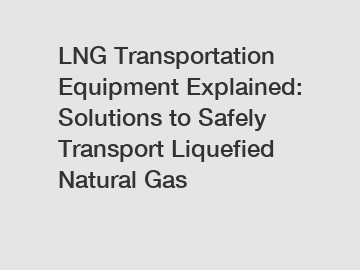Dec. 29, 2023
Transportation
LNG Transportation Equipment Explained: Solutions to Safely Transport Liquefied Natural Gas.
The transportation of liquefied natural gas (LNG) plays a pivotal role in meeting the increasing demand for clean energy sources. As a versatile and environmentally friendly fuel, LNG requires specialized equipment to ensure its safe transport. In this blog post, we will delve into the world of LNG transportation equipment, exploring the solutions that guarantee both safety and efficiency throughout the supply chain.
1. Cryogenic Tanks.

At the heart of LNG transportation lies the cryogenic tank, an insulated vessel designed to store and transport LNG at extremely low temperatures. These tanks are typically double-walled, with an outer wall serving as a protective barrier and the inner wall designed to contain the LNG. They are carefully constructed using materials that can withstand the extreme cold, such as nickel steel alloys or aluminum alloys.
The cryogenic tanks employ a combination of vacuum insulation and foam insulation to minimize heat transfer and keep the LNG at its liquefied state. Advanced control systems ensure pressure and temperature stability, allowing for safe transportation over long distances.
2. LNG Carriers.
LNG carriers, also known as LNG ships, are purpose-built vessels equipped with state-of-the-art technology to facilitate the transportation of LNG across the globe. These vessels come in various sizes, accommodating different volumes of LNG and catering to a range of operational requirements.
LNG carriers utilize advanced containment systems to maintain the LNG's cryogenic temperature during transit. These systems include membrane containment and independent type tanks. Membrane containment uses specialized materials to create a flexible barrier that can expand and contract as the LNG expands and contracts due to temperature variations.
Additionally, independent type tanks consist of self-supporting containers made of stainless steel. These tanks provide enhanced safety as they allow for load sharing between multiple tanks, minimizing the risk of LNG leakage.
3. LNG Road Tankers.
Further reading:LNG road tankers are essential for delivering LNG to consumers in areas not accessible by pipelines. These specialized vehicles provide a safe and efficient means of transporting smaller quantities of LNG to industrial sites, power plants, or LNG refueling stations.
Similar to cryogenic tanks, LNG road tankers are constructed with advanced insulation materials and undergo stringent safety checks. They incorporate advanced safety features such as pressure relief systems and emergency shut-off valves, ensuring the protection of both the driver and the transported LNG.
4. ISO Containers.
ISO containers have revolutionized the transportation of various goods, and LNG is no exception. These standardized containers allow LNG to be transported across multiple modes, including truck, rail, and ship, without the need for specialized equipment at each stage of the journey.
ISO containers enable the safe and cost-effective movement of LNG, thanks to their robust construction and advanced insulation. They are easy to load and unload, ensuring efficiency throughout the supply chain. Additionally, ISO containers are equipped with safety features, including pressure relief devices and flame arrestors, mitigating any potential risks associated with LNG transportation.
Conclusion.
Transporting liquefied natural gas requires a careful blend of advanced technology, engineering expertise, and a commitment to safety. Cryogenic tanks, LNG carriers, LNG road tankers, and ISO containers form the backbone of a well-established LNG transportation system that efficiently and safely meets the growing energy demands of our world.
The continuous advancements in LNG transportation equipment enhance the reliability, efficiency, and overall safety of the LNG supply chain. As natural gas plays a crucial role in transitioning to a sustainable and low-carbon future, these advancements will ensure a smooth transition by enabling the widespread adoption of LNG as a clean energy source.
Investing in cutting-edge LNG transportation equipment is not only pivotal for energy companies and transportation providers but also for our planet's future. By embracing these innovative solutions, we can confidently say that the era of clean and sustainable energy is within reach.
For more LPG Storage solution, marine lng tank, marine LNG filling system supplierinformation, please contact us. We will provide professional answers.
Further reading:Previous: What causes brake pads to crack?
Related Articles
If you are interested in sending in a Guest Blogger Submission,welcome to write for us!
All Comments ( 0 )